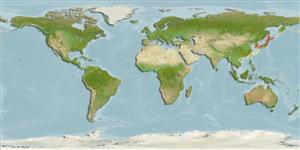分類 / Names
共通名の | 類義語 | Catalog of Fishes(部類, 種) | ITIS | CoL | WoRMS | Cloffa
>
Pleuronectiformes (Flatfishes) >
Pleuronectidae (Righteye flounders) > Pleuronectinae
Etymology: Lepidopsetta: Greek, lepis = scale + Greek, psetta = grouper (Ref. 45335); mochigarei: Specific name refers to the bright white blind side similar to white rice-cake common in Japan.
Eponymy: This is not an eponym but a Japanese name meaning ‘rice-cake flounder’ (mochi = Japanese rice cake traditionally eaten at New Year). (Ref. 128868), visit book page.
More on author: Snyder.
Environment: milieu / climate zone / depth range / distribution range
生態学
海 底生の. Temperate
Northwest Pacific: Korean Peninsula to the southern Sea of Okhotsk.
サイズ / 重さ / 年齢
Maturity: Lm ? range ? - ? cm
Max length : 40.0 cm SL オス/雌雄の選別がない; (Ref. 559)
簡単な記述
検索表 | 形態学 | 形態計測学
Blind side white, with glossy highlights along myotome margins, increasing anteriorly. Pores: supraorbital 1-3; preopercular 8-13; lateral line 95-119. Interorbital space narrow (Ref. 37594).
Life cycle and mating behavior
成熟 | 繁殖 | 放精 | 卵 | 生産力 | 幼生
Vinnikov, K.A., R.C. Thomson and T.A. Munroe, 2018. Revised classification of the righteye flounders (Teleostei: Pleuronectidae) based on multilocus phylogeny with complete taxon sampling. Molecular phylogenetics and evolution, 125:147-162. (Ref. 122998)
IUCNのレッドリストの状況は (Ref. 130435: Version 2024-2)
Human uses
水産業: 商業
用具
特記事項
XMLをダウンロードして下さい
インターネットの情報源
Estimates based on models
Preferred temperature (Ref.
123201): 5.7 - 20.5, mean 11.4 °C (based on 305 cells).
Phylogenetic diversity index (Ref.
82804): PD
50 = 0.6250 [Uniqueness, from 0.5 = low to 2.0 = high].
Bayesian length-weight: a=0.00912 (0.00453 - 0.01836), b=3.10 (2.93 - 3.27), in cm total length, based on LWR estimates for this (Sub)family-body shape (Ref.
93245).
栄養段階 (Ref.
69278): 3.2 ±0.2 se; based on size and trophs of closest relatives
回復力 (Ref.
120179): 低い, 4.5年~14年の倍増期間の最小個体群 (Preliminary K or Fecundity.).
Fishing Vulnerability (Ref.
59153): Moderate vulnerability (39 of 100).
Nutrients (Ref.
124155): Calcium = 35.2 [14.2, 61.8] mg/100g; Iron = 0.264 [0.135, 0.508] mg/100g; Protein = 16.8 [15.4, 18.1] %; Omega3 = 0.363 [0.180, 0.760] g/100g; Selenium = 19.7 [10.1, 41.4] μg/100g; VitaminA = 10.6 [2.5, 43.9] μg/100g; Zinc = 0.492 [0.332, 0.718] mg/100g (wet weight);
